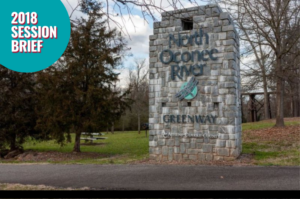By Mike Terrazas
 At least since the development of New York’s Central Park, urban planners have recognized the public value and popularity of city green spaces. Research shows that even limited exposure to green spaces can have significant positive health impacts, and over the past few decades, the North Oconee River Greenway Trail has provided one such option for Athens-Clarke County (ACC) residents.
At least since the development of New York’s Central Park, urban planners have recognized the public value and popularity of city green spaces. Research shows that even limited exposure to green spaces can have significant positive health impacts, and over the past few decades, the North Oconee River Greenway Trail has provided one such option for Athens-Clarke County (ACC) residents.
In a panel discussion that was part of UGA’s State of the Public’s Health conference, five community members offered a case study of the Greenway project and how it navigated the straits of government and public opinion to arrive at its present form as 6.5-mile network of trails. Titled “Greenways to Better Public Health,” the panel was held Oct. 18 in the Georgia Center for Continuing Education.
Public green spaces have been tied to a host of health benefits. Exposure to green spaces—even through windows or in virtual reality environments—has been associated with improved academic performance from students and lower levels of stress markers, such as heart rate and blood pressure, as well as lower levels of the stress hormone cortisol, said Jennifer Gay, associate professor in UGA’s College of Public Health.
Madeline Van Dyck, founding chair of the Oconee River Land Trust, showed a video about the Greenway’s beginnings after it was voted into existence by the ACC unified government in 1992. Van Dyck described the effort as a labor of love, honoring the many individuals who worked on the project both before and after 1992 as “the anatomy and physiology of leadership” who turned a legislative action into actual physical reality.
However the Greenway was not always embraced by ACC leadership, said Melinda Cochran-Davis, assistant director of ACC Leisure Services, who guided the audience through the Greenway’s meandering political path leading to. Nevertheless, she said, despite the ups and downs, its supporters persisted. “Athens is blessed because we have a lot of active, passionate people,” Cochran-Davis said.
Volunteers Jake Maas and Mark Ralston talked both about future plans for the Greenway and related trailways, but also about making creative use of alternate funding options. Maas, director of proposal enhancement in UGA’s Office of Research, serves as the Greenway’s communications and outreach chair and leveraged his grant-writing expertise to help the project land significant funding from the National Fish & Wildlife Service, in addition to the $10 million it secured in 2017 through a successful Athens-Clarke County T-SPLOST vote that will roughly double the current linear mileage of trails.
Ralston talked about the Firefly Trail, a planned multi-use path connecting Athens to Union Point, Ga., along 39 miles of unused railway. Ralston serves as general chair for the effort, which he acknowledged would be expensive—concrete trails, which he said are preferred for their durability, cost about $1.5 million per mile—but also said could literally pay off, citing a Georgia Tech study on the trail’s potential economic impact that determined it would be used by more than a million people and generate some $14.7 million for the local economy each year.
